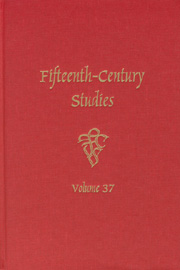Book contents
- Frontmatter
- Contents
- Essays
- Tradition and Innovation in 15th and 16th Century Popular Song Poetry: From Oswald von Wolkenstein to George Forster
- The Poet at the Mirror: René d'Anjou and Authorial Doubling in the Livre du Cœur d'Amour épris
- Modern Translator or Medieval Moralist?: William Caxton and Aesop
- A Battle of “Trechour Tung[s]”: Gaelic, Middle Scots, and the Question of Ethnicity in the Scottish Flyting
- Wheels and Wycliffites: The Role of Sacred Images in Capgrave's The Life of Saint Katherine
- Sympathy for the Devil: Gilles de Rais and His Modern Apologists
- Milieu, John Strecche, and the Gawain-Poet
- Thinking on Paper: Reference Tools, Tables, and Diagrams in Conrad Buitzruss's Compendium (Clm 671)
- Book Reviews
Wheels and Wycliffites: The Role of Sacred Images in Capgrave's The Life of Saint Katherine
from Essays
Published online by Cambridge University Press: 05 February 2013
- Frontmatter
- Contents
- Essays
- Tradition and Innovation in 15th and 16th Century Popular Song Poetry: From Oswald von Wolkenstein to George Forster
- The Poet at the Mirror: René d'Anjou and Authorial Doubling in the Livre du Cœur d'Amour épris
- Modern Translator or Medieval Moralist?: William Caxton and Aesop
- A Battle of “Trechour Tung[s]”: Gaelic, Middle Scots, and the Question of Ethnicity in the Scottish Flyting
- Wheels and Wycliffites: The Role of Sacred Images in Capgrave's The Life of Saint Katherine
- Sympathy for the Devil: Gilles de Rais and His Modern Apologists
- Milieu, John Strecche, and the Gawain-Poet
- Thinking on Paper: Reference Tools, Tables, and Diagrams in Conrad Buitzruss's Compendium (Clm 671)
- Book Reviews
Summary
In Book III of John Capgrave's Life of Saint Katherine, the Virgin warns Katherine that her enemies may call her “Lollard, which, or elve” (III.327), an admonition that has special relevance, not just for the saint, but for this version of her story. This line has contributed to the view held by some researchers that Capgrave expresses sympathy, or at least ambivalence, toward unorthodox views, especially with regard to images and their use in spiritual contexts. Fifteenth-century challenges to the use of the visual arts in religious practice, including veneration of depictions of saints such as Katherine herself, gave rise to debates between the Catholic Church and questioners within the faith, including the so-called Wycliffites, also known as Lollards. Evidence of Wycliffite sympathies encoded within this work, which was written by a mainstream theological official, would suggest that these attitudes extended beyond the small group targeted by the Church. Such widespread dissent to Church traditionalism would support critical views of Wycliffe's ideas as a kind of “proto-Protestant” challenge. However, a closer look at two kinds of evidence within the poem shows its orthodoxy, and even its rejection, of Wycliffite arguments against the adoration of paintings and statues. First, the debates among its characters relating to the use of the visual arts within a reverent context simultaneously raise the question of the work's stance on this argument and provide a potential solution by carefully distinguishing between the secular and the sacred with regard to objects of worship.
- Type
- Chapter
- Information
- Fifteenth-Century Studies 37 , pp. 97 - 112Publisher: Boydell & BrewerPrint publication year: 2012



